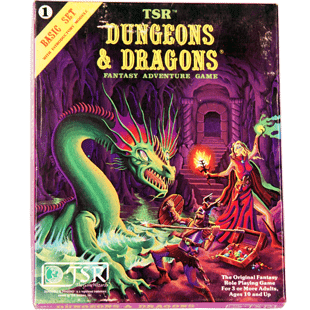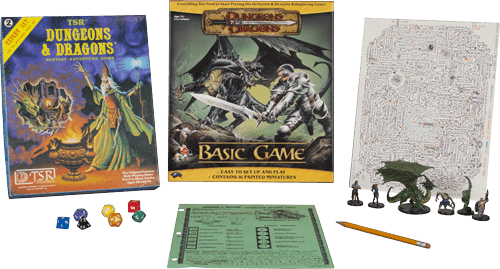
Inducted Year: 2016
In the 1970s, serious war game players Gary Gygax and Dave Arneson added the concept of role-playing to the strategy games they enjoyed. They thus created an entirely new way to play, allowing older gamers to immerse themselves in fantasy worlds not unlike children’s imaginative play. The game soon became popular, and other firms published similar games built upon related mechanics but often employing different fantasy settings, from historic battlefields to outer space. Dungeons & Dragons (D&D) and its imitators actually changed the nature of play.
In Dungeons & Dragons players assume the roles of characters who inhabit a world moderated and narrated by a Dungeon Master, a player who explains the action to others and solicits their reactions to the unfolding story. The Dungeon Master’s storytelling skills and the players’ abilities to imagine add enjoyment to the game. Some aspects of the play are familiar, such as dice. But the special dice for Dungeons & Dragons hold up to 20 sides. Rolling them determines each character’s individual strengths, plots their complex interactions, and decides the outcome of their encounters.
More than any other game, Dungeons & Dragons paved the way for older children and adults to experience imaginative play. It was groundbreaking. And it opened the door for other kinds of table games that borrow many of its unique mechanics. But most importantly, Dungeons & Dragons’ mechanics lent themselves to computer applications. The computer speedily reproduced the role of the Dungeon Master, defining and relating a game’s particular world. And character traits and encounter outcomes, determined by the dice, meshed perfectly with computational random number generation. Eventually, increased graphics capabilities allowed computers to illustrate the imaginary worlds rather than simply describe them. Coupled with the rise of the Internet, players’ characters could now interact in these graphic settings with countless other characters all over the world. These Massively Multiplayer Online Role-Playing Games (MMORPG’s), such as World of Warcraft and many others with diverse thematic settings, are extremely popular today. Without Dungeons & Dragons, these games would not have evolved as they did.

Factoyd: In 1913, author H. G. Wells became the first to publish instructions for war games, upon which strategy games and later Dungeons & Dragons were partially based. As a pacifist, Wells believed that playing at war might eliminate the need for it.




